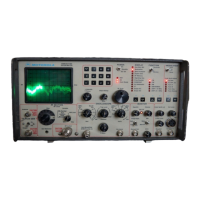BASIC FM TRANSMITTER TESTS
POWER, FREQUENCY,
AND
DEVIATION
A. Basic Terminated Measurements
1.
Connect the Analyzer's RF
In/Out
to the RF
output
of
the unit under test and make the other connections as
shown in figure 4-7.
CAUTION
For
power
output
measurements, connect a transmitter only to the Analyzer's
RF
In/Out.
Do
not connect it to the
Analyzer's antenna port.
The
built-in RF load dissipates
up
to 50 W for three minutes and up to
125
W for one minute.
If
a technician keys
a high-power transmitter into the Analyzer for a time long enough to threaten overheating the power-measuring
circuitry, the system's audible alarm sounds and the display changes to read the
RF
LOAD OVER-TEMP warning
to un-key.
2.
Set DISPLAY to
Gen/Mon
Mtr,
FUNCTION
switch to Monitor FM, and
MONITOR
Squelch control to thresh-
old. Enter the correct transmitter carrier frequency via the keypad
or
RF Memory table.
3. Set the
attenuator
to
-30
dB.
For
low-power transmitters, it may be necessary to reduce the attenuator setting to
unsquelch the monitor.
Too
high
an
attenuator
setting
or
too
tight a squelch setting inhibits the frequency error
display. Accurate measurements require sufficient signal level from the radio to fully quiet the Analyzer's Monitor
receiver.
4. Use good quality cables
of
minimum length because cable-loss can be a significant factor in RF power measure-
ment, especially at
UHF
and above. Key the transmitter
and
read the power indicated
on
the display.
5.
Read any transmitter frequency error indicated
on
the display.
6. Refer to the radio's service manual to determine
if
POWER
and FREQUENCY are within spec limits and de-
termine
if
any adjustments are required.
7. Proceed to check
MODULATION
as follows:
a.
Turn
off
all modulation sources
at
the Mod
Out
of
the Analyzer in order to check the level
of
PL
or
DPL
deviation from the transmitter.
b. Key up transmitter with appropriate
PL
or
DPL
enabled and read
DEVIATION
from the
GEN/MON
MTR
DISPLAY. Refer to radio service manual to determine
if
adjustment
is
necessary.
c.
With
PL
or
DPL
modulation properly set, introduce 1 KHz modulation to transmitter audio input by ad-
justing the 1 KHz LEVEL control. Check service manual to determine the minimum level required for proper
MIC sensitivity as well as the maximum level required to insure proper IDC function. Read
MOD
OUT
levels
on the DVM by temporarily switching the DISPLAY to
DVM/DIST,
ACVM.
d. At the maximum audio input level, read DEVIA
nON
on the display and verify
that
it falls within the maxi-
mum rated system deviation specified in the radio's service manual. Make adjustments as required.
e. Verify proper MIC sensitivity by setting Mod
Out
Level to the minimum threshold level per the service manual
and reading corresponding DEVIATION
on
the display.
B. Off-The-Air Measurements.
1.
Connect the TEKA-24A pick up antenna to the Analyzer's antenna connector. Pull the Variable control
out
to en-
able the antenna port.
2. Operate the transmitter under test either into its own antenna
or
into a dummy
RF
load, as shown in figure 4-7.
3. Set DISPLAY to
Gen/Mon
Mtr,
FUNCTION
SWITCH
to Monitor FM,
MONITOR
Squelch control to thresh-
old, and enter the correct carrier frequency.
4-15

